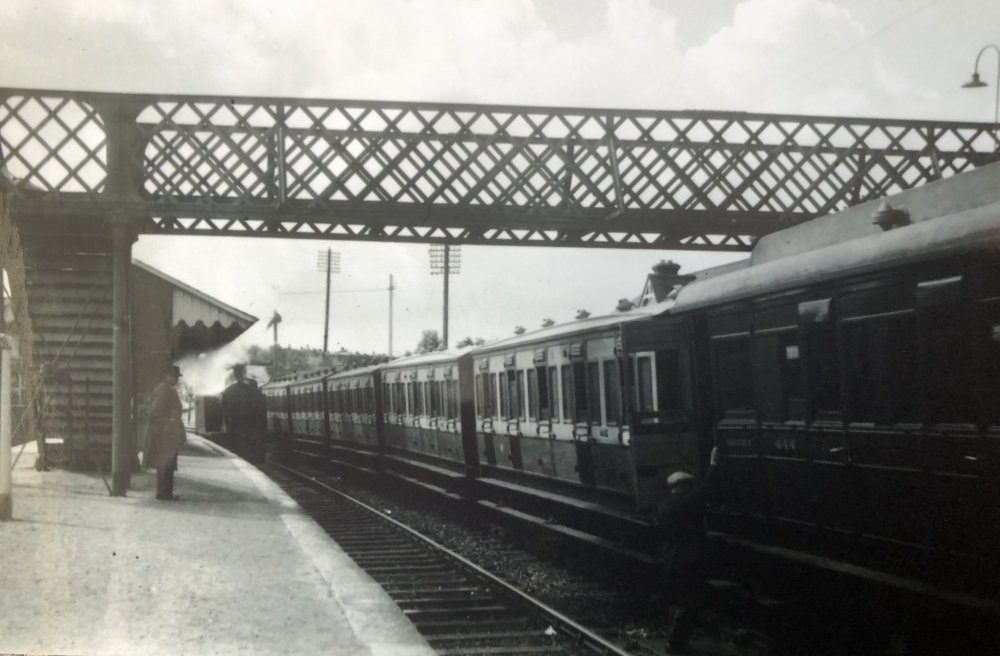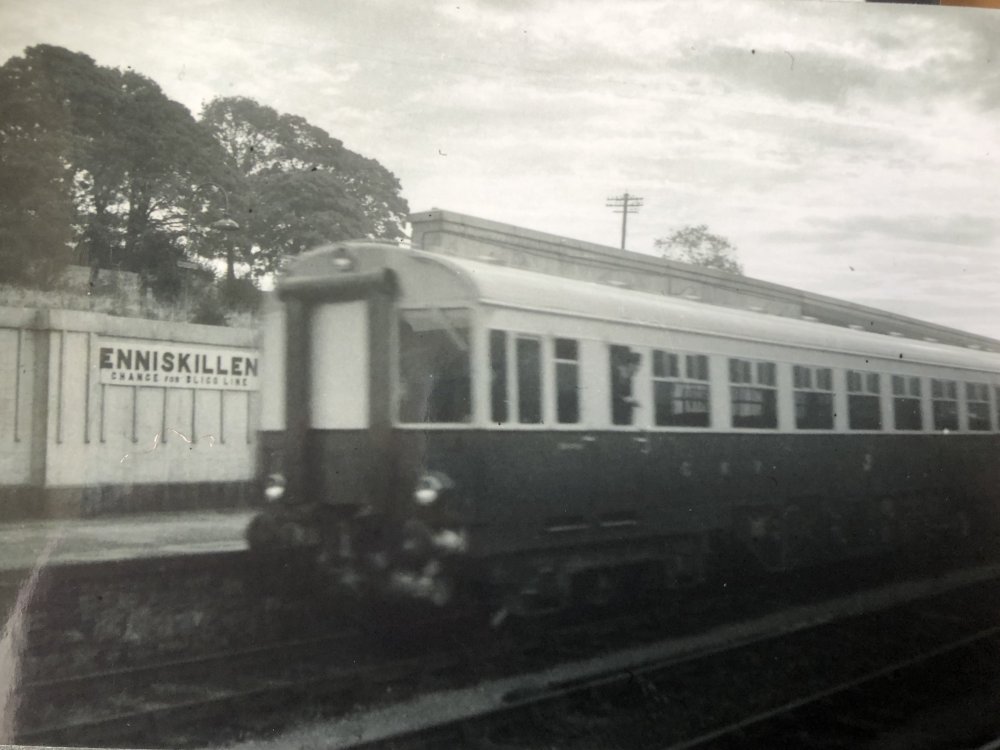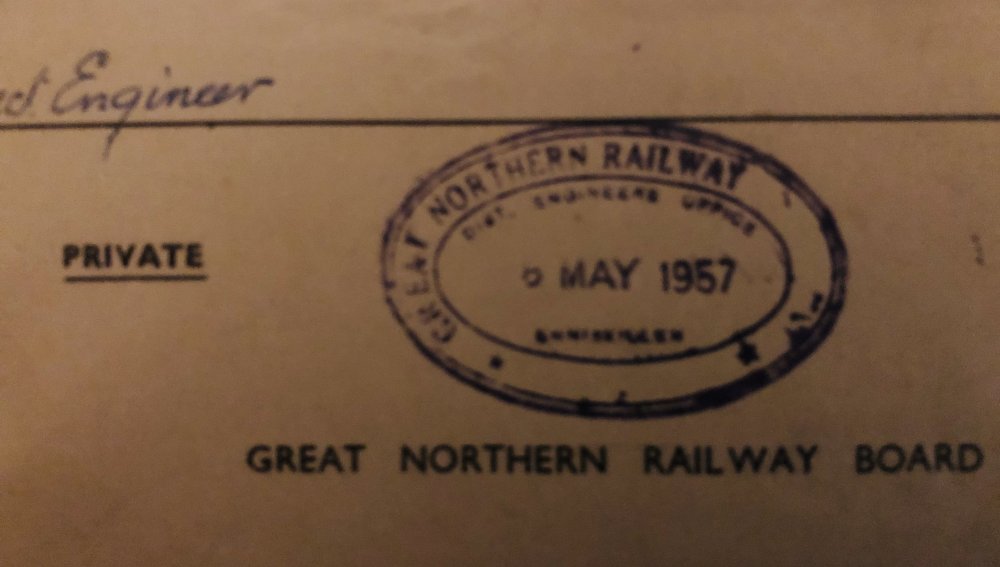-
Posts
15,833 -
Joined
-
Last visited
-
Days Won
393
Content Type
Profiles
Forums
Events
Gallery
Blogs
Store
Community Map
Everything posted by jhb171achill
-
Yes, very much so. A GNR coach of 1940s / 50s origin.
-
Which Marks Model do you mean - I'm unaware of one that resembles this coach?
-
Wow, cab detail and all, Galteemore - that loco is an absolute beauty - well done indeed! Another little lady that would have been great at Downpatrick!
-
Gawd bless your eyesight, NIR! Maybe a "flying pitchfork"? Or a Scandinavian beer bottle opener?
-
Yes, the date seems to be 1944; it is with other photos from that year in sequence. On the same day he took a picture in Lisburn. I wonder if the people on the bridge are Orangemen? Do we know for a fact that orange events were curtailed that year? My understanding is that had not been since a time when the British government actually banned them for a few years in the 1850s or something. This might explain the carriages, and the loco running round. maybe there's a wartime shortage of GNR stock all over the place, and the GNR has borrowed secondary stock from the DNG to deal with a party from Newry to Scarva. The loco is running round, thus will reverse onto the far end of the train to go back. Maybe the people up on the bridge are coming to get back onto it. The man in the flat cap could be a porter?
-
Now that's a very interesting possibility, Airfixfan. It could very well be - I hadn't even thought of that. Were orange-related matters curtailed in those times? I didn't know that. It could well be something of the sort. Was there a military base anywhere near Newry? Whatever is happening this day, a tank engine is running round the train, by the look of it. The branch was still open, but it would have used the platform on the left. I sent the pic to a gentleman this afternoon who would be the leading expert on the GNR nowadays, I'll be interested to hear his views.
-
Yes! that's the one.... listen to youtube clips of those beasts revving up.... I think there may be preserved examples in Norway.
-
That's correct - it's as good as certain that no SLNCR carriage ever left the line - as you say, they had barely enough for themselves. Senior remarked in the past that E W Monaghan and G F Egan were both embarrassed at the state of their few roadworthy carriages towards the end. I am only aware of two that were repainted at all in the 1950s (one of the bogies and six-wheeled third brake No. 4). Midland Man - you're possibly also thinking of the two SLNC locos (Loughs Erne & Melvin) which went to shunt in Belfast. This was after the SLNCR closed - the UTA bought them and numbered them 26 and 27. No. 26 wasn't used much and was withdrawn by about 1965 but 27 "Lough Erne" of course survived and is now at Whitehead.
-
Yes, it would. So it must be 13th July 1944. Got to be the only time my father went anywhere that sort of stuff! It would actually be interesting to get hold of a GNR traffic circular for that date to see what was happening. I do know that they brought in excursions from many places during the whole 12th / 13th July period. As a child, at that time of year, we were off to Dublin or Mayo for the holliers.....! On one occasion, Senior saw a train composed of both GNR and DNGR stock in Enniskillen, of all places! A journey across the INWR in those old six-wheel thirds would not have been for the faint-hearted! He did not recall what the reason was, but thought that it was something to do with a pilgrimage. So, the obvious "quiz question" is, how far did DNGR or SLNCR stock get away from home? GNR stock were occasional visitors to Sligo, while any time the SLNCR was busy, they used to get in MGWR / GS / CIE six-wheelers; thus, such things were to be seen now and again in Enniskillen. But CIE and the GN were big companies - how far away did SLNC and DNG stock go? The DNG at one time had an advertised through coach to Belfast, which was hitched onto a GN train in Newry, so we'll discount that one. Answers to that question could be of great interest to modellers..... After the GNR was broken up in 1958, one wooden, brown-liveried GNR bogie worked on the West Cork, of all places, for a short time. Imagine a train with a GSWR 2.4.2T, a brand new shiny tin van, this GNR coach, an old Midland six-wheeler and a new laminate on a train! Possible.
-
Interesting, NIR. The late Tony O'Shaughnessy had an interest that few knew of in Scandanavian railways and he sent me some vid clips some years ago of Norwegian GMs. They sounded EXACTLY like a 141 to me, but didn't look remotely like a typical EMD product. Any idea what they were? I've long since deleted the clips.
-
Somebody had that photo on ebay a year or two ago, advertised as a CIE 121 class loco. I contacted the seller to advise that it was, in fact, an American loco, as evidenced by the length, the six-wheel bogies, and the central coupler and absence of buffers, but he insisted I was wrong and he was right. In an effort to make the point that its unfair to a potential buyer to put up wrong information, I persisted for a while and sent him pics of a real 121, but he remained unconvinced. There's some eejits so blind they can't see hard fact in front of them! I wonder does anyone know where the above "larger-121-class" actually operated? It would be interesting to know if any still exist, maybe shunting in some industrial complex in the USA? And it's got handrails - the Irish ones were delivered without!
-
Contact Mayner, of this website; he is J M Design, who do the very kit you're looking at.
-
Lumsden locomotive emerges from mud after 93 years
jhb171achill replied to K801's topic in General Chat
Exactly the same issues or related ones in South America. Some of their lines had mostly British locos, some all-American, and some manufacturers from mainland Europe (Germany in particular) had a presence there too. I saw some British and American beauties last year in Brazil.... -
Now that I'm looking again at this (the original print is small) on a large screen, I notice a few more details. Look at some of the doors of the DNGR carriages - they have been more recently painted, thus the main paintwork is faded. Look at the roof lines of the carriages - all higgledy-piggeldy, yet they are parked on some of the best track in the country. Thus, their suspension is far from good in condition! This must be a spare rake of secondary stock. The signal indicates the road is clear looking south. Thus, the loco is running away from the photographer to the far end; he will hitch up and go. Nobody is about. Are they awaiting the return of their passengers? There's no sign of anyone in the train - you'd expect some of them, anyway, to be leaning out of open windows. The bush in the distance has foliage on it - it's summer, thus again possibly July. I cannot for the life of me imagine what Senior was doing there that day. He never had any business, nor knew anyone, in that area at that time. The orangemen - if that's what it is -would not be running any events that, let us say, might interest him! However, if the grapevine had told him that a rake of old DNGR stock would be allowed out of the Cooley Peninsula that day, THAT would have piqued his interest!
-
GNR / DNGR time! An excursion in 1944. GNR brake nearest camera on the right, and a rake of Greenore carriages. I think this may be Scarva, looking south but I am not sure. Other opinions, anyone? I suspect that’s the platform on the left for Lenaderg, Lawrencetown and Banbridge, where it connected with the Lisburn - Banbridge - Newcastle line.
-
UTA/NIR "Enterprise" dining car
jhb171achill replied to Lambeg man's question in Questions & Answers
That’s absolutely correct. I worked with Ken in the late ‘70s on 861 and the NCC trio - 68, 241 & 23X (or something!) -
UTA/NIR "Enterprise" dining car
jhb171achill replied to Lambeg man's question in Questions & Answers
My understanding is that when the RPSI got hold of it there was a serving / bar area where the very last 2nd class seating area is shown. The dividing partition between 1st and 2nd class areas was gone. One, at least, of the toilets had become a store. I remember getting cleaning stuff in there. In the kitchen area the serving hatch, at an angle, had gone, and a right angled corner was there instead. The server / bar was facing the seats. Now, I say that it is my "understanding" that this was so. The reason I say that is that I do not remember the RPSI re-designing the interior, but this COULD have happened; John Richardson would be about the only person who could answer that, as he looked after the car and catering before I took over in 1988. By that stage this vehicle was out of use, replaced by UTA 87, the interior of which WAS completely rebuilt by the RPSI - I should know, I designed it! If in earlier days the RPSI DID alter the interior, then I cannot comment on what it had been like. I do recall vaguely that its entire interior panelling was very garish 1960s red and grey formica plastic! -
From Gatwick to Downpatrick - DBSO 9712 (8918)
jhb171achill replied to NIR 450 ‘Castle’ Class's topic in Irish Models
It would have been interesting to see this beast in traffic! Presumably they'd have had to fit one or more of the GMs with all the relevant gubbins and techyology to be worked from the far end. Would have been great on Derry services or rugby specials to Lansdowne Road..... -
One would have expected it to be eventually filled up on a regular rather than occasional basis - as I mentioned elsewhere, I reckon that after a while it would have been a three or maybe four-car AEC set. Being a new idea, it never got fully into its stride unfortunately.
-
Today’s GNR view was taken at Enniskillen in mid-September 1957, about ten days before the entire railway system in Fermanagh closed, thanks to Stormont. Railcars remained a rarity in this part of the world. Only three months earlier, this working had started - to be cut short before many were even aware of it. This railcar, often with a single brake third in tow, operated non-stop (other than reversal at Omagh) to Belfast. I am unaware of any other passenger train which did not stop at Portadown. Thus, views of it are rare. Rarer still was the prospect of Senior considering anything diesel to be worth photographing!
-
I’m thinking that’s a good idea, yes. Dugort Harbour is a terminus, so I would want the next thing to be a through station probably - small one with a short siding or two and a cattle bank.... something vaguely along those lines. Tonragee, for example, was a remote location on the Achill branch where there was a short-lived fish siding. There was once a plan to build a halt including red-brick station building there, but it wasn’t built - and the fish siding was reported as derelict within ten years of the branch opening... something like that might suit.
-
Senior had this rubber stamp. I had it eventually and I used it to date my schoolbooks.... the year date went up to 1972..... You can see where GNR “Ireland” was - the GNR wording was now off centre because the word “Ireland” had been picked off when it became the GNR(B).
-
Not at all discourteous, David! Yes, my grandfather designed these things to carry cattle after the Killala, Achill and Clifden lines closed. I put a drawing of it in the Achill book and the same one is going in the Clifden book, as it's relevant there too. I had never seen a photo of one before. It is, as far as I know, the only road vehicle he did any design work for - such matters were around that time all transferred to the "road people" in Broadstone. All I know is that they initially built four, with presumably more to follow later. I think, but am not sure, that it had a Leyland engine.
-
Putting decals on first, then very heavy weathering, is probably the easiest option for now....
- 309 replies
-
- 1
-

-
- mgwr
- 21mm gauge
-
(and 1 more)
Tagged with:
-
Very much so. On the Achill branch at first, normal trains were "E" class tanks, but Newport and Mulrany fairs and seasonal harvester's emigration trains brought in the 2.4.0 tender engines.
- 309 replies
-
- 1
-

-
- mgwr
- 21mm gauge
-
(and 1 more)
Tagged with:
.png.c363cdf5c3fb7955cd92a55eb6dbbae0.png)





